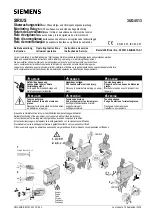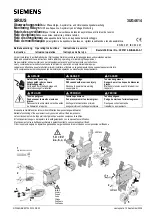
I.L. 40-386.3
2-22
(10/94)
2)
Weak end trip on internal fault
(Figure 2-30)
The output of AND-65 (start echo keying) together with no output from OR-40
(pilot trip relays), and with output from OR-44 (low voltage condition) will satisfy
AND-66; weakfeed trip will be performed after 50 ms via OR-2. The timer delay
is for coordination because the voltage trip units are non-directional.
2.5.7
Reclose Block on Breaker Failure Squelch
For a pilot system, the BFI signal can be used to stop (for a blocking system) or start
(for permissive schemes) the carrier channel and allow the remote terminal to trip
should the local breaker fail to trip. The problem is how to inhibit the remote terminal
from reclosing.
REL 301/302 solves this problem by the RB on BF squelch logic in the RI/RB software.
This logic is
as shown in Figure 2-19
, which includes AND-61A and a 132/0 ms timer.
If the BFRB is set to “YES” the logic will initiate RB at 132 ms (about 8 cycles) after the
fault is detected by
∆
I or
∆
V, assuming the pilot is enabled and the TRSL signal is re-
ceived on any 3-pole high speed trip operation (Zone1 trip, pilot trip or high set trip).
2. 6
PROGRAMMABLE CONTACT OUTPUTS
Most of the functions described in this section can be directed (single or combined) to
the programmable contact outputs.
Refer to Section 4.10 for further details
.
2. 7
FAULT DATA
The REL 301/302 system saves the latest sixteen fault records for all zones. The latest
two fault records can be accessed either via the front panel or via the communication
port. Fault records 3 thru 16 can only be accessed via the communication port. On the
front panel, the “L- FLT” information is of the last fault, the “P- FLT” information is of
the previous fault. These displays contain target information. When targets are avail-
able, the last fault related LEDs flash. Once per second if only L-FLT contains targets,
twice per second if two or more fault records are contained. These records can be de-
leted by applying a rated voltage to the Ext. Reset Terminals (TB4/7 and TB4/8), or
through a remote communication interface. By pressing the Reset pushbutton, the
LEDs will be reset but the fault information will still be retained.
The activation of fault data storage is controlled by the selection of TRIP/Zone2/
Zone2, Zone3 in the Flt Data
(FDAT)
function, where:
TRIP
— to store fault data only if trip action occurs.
Zone2
(Z2TR)
— to store fault data if Zone2 units pick up or any trip action occurs.
Zone2, Zone3
(Z2Z3)
— to store fault data if Zone2 or Zone3 units pick up or any trip action
occurs.
Summary of Contents for REL 301
Page 1: ......
Page 8: ......
Page 17: ...I L 40 386 3 1 10 10 94 2682F39 Sheet 1 of 2 Sub 2 Figure 1 2 REL 301 302 Layout Vertical...
Page 18: ...I L 40 386 3 10 94 1 11 2682F39 Sheet 2 of 2 Sub 2 Figure 1 3 REL 301 302 Layout Horizontal...
Page 19: ......
Page 20: ......
Page 44: ......
Page 46: ......
Page 48: ......
Page 49: ......
Page 51: ......
Page 53: ......
Page 54: ......
Page 55: ......
Page 56: ......
Page 57: ......
Page 60: ......
Page 62: ...I L 40 386 3 10 94 2 41 Figure 2 32 CO 2 Curve Characteristics 619596 Sub 2...
Page 63: ...I L 40 386 3 2 42 10 94 Figure 2 33 CO 5 Curve Characteristic 619597 Sub 2...
Page 64: ...I L 40 386 3 10 94 2 43 Figure 2 34 CO 6 Curve Characteristic 619598 Sub 2...
Page 65: ...I L 40 386 3 2 44 10 94 Figure 2 35 CO 7 Curve Characteristic 619599 Sub 2...
Page 66: ...I L 40 386 3 10 94 2 45 Figure 2 36 CO 8 Curve Characteristic 619600 Sub 2...
Page 67: ...I L 40 386 3 2 46 10 94 Figure 2 37 CO 9 Curve Characteristic 619601 Sub 2...
Page 68: ...I L 40 386 3 10 94 2 47 Figure 2 38 CO 11 Curve Characteristic 619602 Sub 2...
















































